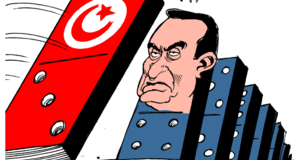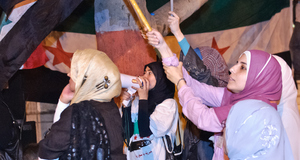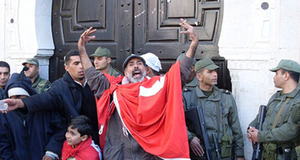Civil-Military Linkages and Authoritarian Regime Survival During the Arab Spring: Understanding Different Outcomes of the Revolutions
By
2022, Vol. 14 No. 05 | pg. 1/1 AbstractStrong linkages between autocrats and the military are often seen as a necessary condition for authoritarian regime survival in the face of uprising. The Arab Spring of 2011 supports this contention: the armed forces in Libya and Syria suppressed the mass protests, while the military in Tunisia and Egypt refused to engage in the counterinsurgency efforts. To better understand these divergent outcomes, the following paper examines the factors that affect civil-military linkages in authoritarian regimes in the Middle East and North Africa. The paper argues that there are three main methods through which autocrats can either increase or decrease their cohesiveness with the armed forces: counterbalancing the military, distributing patronage or material benefits, and institutionalizing the military. Through these methods, autocrats can boost the loyalty of armed forces, improve the robustness of coercive apparatus, or place constraints on the power of the army, which, in turn, influence the military propensity to support the regime during mass uprisings. In 2010 Taker al-Tayeb Mohamed Bouaziz, a Tunisian street vendor set himself on fire after being harassed by a policewoman (Brownlee, Masoud, and Reynolds 2015, 10). His fiery suicide became a catalyst for mass demonstrations not only in Tunisia but also across the Arab world. The wave of protests in 2011 spread to Egypt, Libya, Yemen, Syria, Algeria, Iraq, Mauritania, Morocco, Sudan, and the Gulf States. This period of history was called the Arab Spring. The Arab Spring brought hope for changes in authoritarian regimes in the Middle East and North Africa, but its results were diverse. Some demonstrations gained success in overthrowing autocratic regimes, while other revolts were suppressed: in Tunisia, Egypt, and Yemen the authoritarian regimes broke down, but in Bahrain, Libya and Syria, the military repressed the mass revolts and protected autocratic regimes (Brownlee, Masoud, and Reynolds 2015, 4). Two main outcomes of the Arab Spring were either the overthrow of the regime or its survivability. Looking at what affected these results, the role of the military and its linkage to autocrats becomes important indicators. The overthrow of the regimes in Egypt and Tunisia was possible due to the military refusal of quelling the demonstration, whereas the maintenance of the regimes in Syria and Bahrain happened because of the military loyalty and readiness to use coercive power. Autocrats’ various levels of personal linkages to the military can explain these differences in the military’s behaviors during the mass uprising. The methods through which autocrats affect their cohesiveness with the military include such tactics as counterbalancing the military, distributing patronage or material benefits, and institutionalizing the military. Through these three methods, autocrats can contribute to the loyalty and robustness of their coercive apparatus or place constraints on the function and power of the army, which, in turn, affects the military propensity to support the regime. To keep the military in check, autocrats can use the strategy of counterbalancing. According to Geddes, counterbalancing is an important coup-preventing mechanism as it allows creating alternative forces to counter the power of the military and protect the regime from it (Geddes 2006, 2). Autocrats can do so by establishing a strong political party, participating in regular elections, or creating a security apparatus (Geddes 2006, 3). The role of the first two methods, parties and elections, lays in their ability to demonstrate popular support and loyalty of citizens to the regime (Geddes 2006, 10). Such demonstration reduces the likeability of military seizure, as the military will not rise against a popular and largely supported regime. Its intervention could lead to chaos within a state, which is not in the interests of the military. However, poor management of parties and elections will weaken civil-military linkages. It can reduce the military’s interests in the regime and increase the chance of the military to step in when there is widespread dissatisfaction with autocrats. Such situations happened in Libya and Yemen during the Arab Spring: the military troops split into fractions, part of which then sided with the opposition due to their low stake in the regime. In the case of Yemen, the military restructured itself and removed several leaders in the Yemeni government, which then resulted in the overthrow of the regime (Carvajal 2012). In the case of Libya, the autocratic regime survived the protests, but it fell after the NATO intervention in 2011.Another counterbalancing strategy, as Geddes argued, is the creation of an alternative militia or security apparatus. The establishment of alternative intelligent forces also keeps the military in check and gives a leveraged in ensuring the maintenance of the regime (Geddes 2006, 14). Alternative intelligent forces are mainly institutional and operate under the direct control of autocrats. Across the Middle East, several autocratic regimes implied this strategy: Iraq has the Social Republican Guard, Iran has the Revolutionary Guard, Saudi Arabia has the General Intelligence Presidency, etc. These secret apparatus monitor the situation within a country, prevent potential coups and balance autocrat’s power to other state institutions on a divide-and-rule principle. Nevertheless, while a secret apparatus might be more effective than counterbalancing the military through parties and elections, they also weaken civil-military linkage. Their formation places the military in a marginal position: it declines the institutional role and power of the military, as well as leads to the grievances of the military elites and officers (Nassif 260, 2015). For instance, Mubarak through using this strategy of counterbalancing the military significantly weakened the civil-military linkage in Egypt, which resulted in the refusal of the military to protect him during the demonstrations. Under his presidency, Mubarak continued strengthening the role of the secret police and investing in the Central Security Forces (Nassif 2015, 261). The military’s control over coercive means was reduced, which created a situation of competition for the military troops. Mubarak’s later political developments further contributed to the erosion of the military position within the state. As a result, the military did not intervene and obtained from using force against demonstrations in 2011. Similarly, Ben Ali’s Presidential Guard in Tunisia also marginalized the army. The military was poorly funded, badly equipped and underpaid (Nassif 2015, 271). Continuous regime support to the Presidential Guard instead of the army distanced the military from the regime and affected its behavior during the Arab Spring. Additionally, it is important to mention that in the case of Egypt, even after Mubarak’s overthrow, the military still pursued the strategy of gaining back its power. It sensed the dissatisfaction with a newly elected president, Mohamad Morsi, and stepped in to take control of the country. Therefore, as discussed above, the counterbalancing strategy is both advantageous and disadvantageous for autocrats: it can either strengthen personal linkage with the military or weaken them. But it is not the only means of affecting leader-military linkage. The distribution of patronage and material resources is another significant factor that determines the military support of the regime and its behavior during crises. The distribution of particular material benefits to the military allows autocrats to gain the army’s loyalty and increase their despotic power (Bellen 2004, 144). In oil-rich countries in the Middle East and North African regions, such distribution is possible due to oil rents. Autocrats keep high salaries of the military officers to boost civil-military relationships, as well as supply the military with modern arms and ammunition to increase the “repression effect” of a state (Bellen 2004, 144). Even if the citizens want democracy, resource wealth ensures the strength of the armed forces and the military’s stake in the regime prevents democratic aspirations (Ross 2001, 315). According to the statistical data, major states of oil exports tend to spend significantly on their militaries compared to oil-poor countries (Brownlee, Masoud, and Reynolds 2015b, 52). This means that the distribution of material benefits in oil-rich states would have a stronger effect on leader-military linkage and the capacity of the military to coerce (Brownlee, Masoud, and Reynolds 2015b, 52). For instance, Libya and Bahrain are two oil-rich countries that have robust defense hardware. Compared to them, Tunisia and Egypt are two oil-poor states with relatively small spending on armed forces, whereas the Tunisian army is considered to be one of the poorest and smallest armies in the region (Nepstad 2011, 489). During the Arab Spring, both Libya and Bahrain were able to confront mass revolts, while Tunisia and Egypt experienced a regime change. Thus, by providing military elites with economic benefits, autocrats tighten their personalistic linkages with armed forces. However, it does not mean that in relatively oil-poor countries the civil-military linkage could not be strong. Rather than distributing material resources, autocrats can use the distribution of patronage to influence the military’s behavior. The distribution of patronage increases the military’s direct stake in the maintenance of the regime because the regime provides the military with privilege status and multiple political advantages. Autocrats can rely on communal ties with armed forces, and appoint military personnel based on their ethnic, sectarian or tribal identities (Makara 2016, 211). This, even more, boosts the costs of defection and reduces the possibility of military dissidents. The employment of such a strategy was seen in Syria, where the military shares sectarian identity with Assad. By appointing mainly the Alawite military officers, Assad increased the Alawite dominance in the army and provided them with privileged status, which was dependent on the regime maintenance (Makara 2016, 219). Hence, during the Arab Spring, the Syrian army could not easily abandon Assad’s regime due to the fear of losing their benefits (Nepstad 2011, 489). Contrary to the Syrian army, the military officers in Tunisia did not have a major risk during the demonstrations in 2010. Tunisian military officers and the elite represented a wider socio-economic spectrum. They did not have any major political or economic interests in the regime, and could relatively easily change its behavior following the situation. Adding their marginal state in the country due to a strong secret apparatus, the Presidential Guard, the military sided with the protestors during the Arab Spring and supported the revolution in Tunisia (Nepstad 2011, 487). Yet, the distribution of patronage and material resources, as well as counterbalancing strategy were not the only factors affecting the civil-military linkage and the outcomes of the Arab Spring. The degree of military institutionalization is another important factor. As Bellen argues, the institutionalization of the coercive regime increases democratic tolerance of the military and reduces the likeability of coercive methods during mass demonstrations (Bellen 2004, 145). When the military is institutionalized, it becomes more bureaucratic, predictable, rule-governed, and meritocratic (Bellen 2004, 145). It sustains its organizational integrity and autonomy from the state. Military personnel and officers accrue professional identity that separates them from the state and generates a distinct mission to serve the citizens (Bellen 2004, 145). Hence, the more institutionalized military is, the less it perceives itself as closely related to the regime. The military becomes acceptable for progressive changes and less supportive of an autocrat compared to the military based on patrimonialism and favoritism. During the Arab Spring, this factor potentially affected the military’s behaviors in those states that had a more institutionalized army such as Tunisia. The Tunisian military was more hierarchical, structured and apolitical. It was committed to providing stability and security to Tunisian citizens rather than the personal protection of a dictator, which pushed the military to support the demonstration (Nepstad 2011, 489). Unlike the Tunisian army, the military in Syria and Bahrain was less institutionalized and based on patrimonialism with communal bonds. The Syrian army was also involved in internal security issues and Assad’s protection, which strengthen their linkage to the regime, while in Bahrain the Shia majority was excluded from the mainly Sunni army (Makara 2016, 219). Nevertheless, the institutionalization of the military similarly can lead to more oppressive apparatus instead of democratic tolerances of the military. It can produce a highly bureaucratic system where the main function of military officers would be to serve laws. The story of Eichmann in Eastern Germany, described by Hanna Arendt, shows how a law-abiding officer became a product of an “evil” system. Eichmann was a German SS high official, who participated in the organization of the Holocaust. Arendt presents how his professional conduct, strong belief in laws and the system made him commit unethical actions such as the orders to kill thousands of the Jewish people. Thus, this example challenges Bellen’s argument about the initialization of the military by stating that a highly bureaucratic army can also lead to more despotic power. Adding patrimonialism and material benefits to this system, autocrats strengthen their civil-military linkage and reduce the chance of military switching sides during uprisings. All in all, the military played a crucial role during the Arab Spring protests. In particular, civil-military linkages affected different outcomes of the Arab Spring. As discussed above, such strategies as counterbalancing the military, distributing patronage or material benefits, and institutionalizing the military determined the behaviors of the military during the mass uprising. The military either decided to suppress the protests due to its high stake in the regime, common identity and patrimonial character as in Libya and Syria, or refused to engage because of its organizational autonomy, poor interests and marginal position as in Tunisia and Egypt. It is hard to determine one particular factor with a strong effect on the civil-military linkage, as autocrats do not usually use one tactic alone. They employ the combination of counterbalancing, distributing material benefits, and institutionalizing the armed forces for a better control system of the military. In any case, the nature of civil-military relationships will be influenced through the use of these strategies, which in turn will shape the outcomes of a mass uprising: overthrows or survival of autocratic regimes. ReferencesArendt, Hannah. Eichmann in Jerusalem: A Report on the Banality of Evil. New York: Viking Press, 1963: 112-150. Bellin, Eva. "The Robustness of Authoritarianism in the Middle East: Exceptionalism in Comparative Perspective." Comparative Politics 36, no. 2 (2004): 139-157. Brownlee, Masoud, Reynolds, Masoud, Tarek E., and Reynolds, Andrew. “Introduction: The Third Arab Spring.” The Arab Spring : Pathways of Repression and Reform. First ed. Oxford; New York: Oxford University Press, 2015: 1-15. ——— 2015b. “Lineages of Repression.” The Arab Spring : Pathways of Repression and Reform. First ed. Oxford; New York: Oxford University Press, 2015: 40-63. ——— 2015c. “Why Breakdowns Did Not ALways Produce Transitions.” The Arab Spring : Pathways of Repression and Reform. First ed. Oxford; New York: Oxford University Press, 2015: 169-210. Carvajal, Fernando. “Military Restructuring in Yemen: Unravelling a Tangled Web.” Comment Middle East, April 26, 2012. https://web.archive.org/web/20121204053839/http://commentmideast.com/2012/04/military-restructuring-yemen/. Geddes, Barbara. “Why Parties and Elections in Authoritarian Regimes?” MS, University of California, Los Angeles, 2006: 1-30. Makara, Michael. "Rethinking Military Behavior during the Arab Spring." Defense & Security Analysis 32, no. 3 (2016): 209-223. Nassif, Hicham. "Wedded to Mubarak: The Second Careers and Financial Rewards of Egypt's Military Elite, 1981-2011." The Middle East Journal 67, no. 4 (2013): 509-530. Nassif, Hicham Bou. "Generals and Autocrats: How Coup‐Proofing Predetermined the Military Elite's Behavior in the Arab Spring." Political Science Quarterly 130, no. 2 (2015): 245-275. Nepstad, Sharon Erickson. "Nonviolent Resistance in the Arab Spring: The Critical Role of Military‐Opposition Alliances." Swiss Political Science Review 17, no. 4 (2011): 485-491. Ross, Michael Lewin. "Does Oil Hinder Democracy?" World Politics 53, no. 3 (2001): 325-361. Suggested Reading from Inquiries Journal
Inquiries Journal provides undergraduate and graduate students around the world a platform for the wide dissemination of academic work over a range of core disciplines. Representing the work of students from hundreds of institutions around the globe, Inquiries Journal's large database of academic articles is completely free. Learn more | Blog | Submit Latest in Political Science |


















